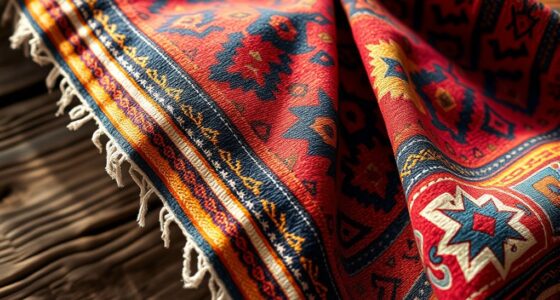Moorish architecture reflects a rich Islamic heritage with stunning geometric and arabesque patterns, ornate tilework like zellij, and elegant arches such as horseshoe and muqarnas styles. You’ll notice intricately decorated courtyards, water features, and detailed woodwork and stucco surfaces that highlight craftsmanship and symmetry. Its legacy continues through modern adaptations that blend traditional motifs with contemporary design, revealing a timeless influence. Exploring these features reveals a mesmerizing legacy that’s worth discovering further.
Key Takeaways
- Distinctive use of intricate geometric and arabesque patterns, emphasizing infinity and divine unity through tile mosaics and decorative motifs.
- Architectural features like horseshoe and muqarnas arches symbolize spiritual harmony and create visually complex, ornate structures.
- Central courtyards with water features and lush gardens foster tranquility and reflect paradise symbolism in Moorish design.
- Emphasis on craftsmanship with detailed woodwork, stucco, and tilework that showcase artistic mastery and cultural expression.
- The legacy includes modern adaptations of Moorish motifs, influencing contemporary architecture with intricate detailing and harmonious layouts.
Origins and Historical Context

Moorish architecture originates from the Islamic culture brought to the Iberian Peninsula by North African Moors during the early medieval period. Their influence grew through thriving Islamic trade routes that connected the region to North Africa, the Middle East, and beyond. These trade networks facilitated cultural exchange and introduced new architectural ideas. You’ll notice that Moorish military architecture, such as fortified castles and defensive walls, reflects the need for protection and control during turbulent times. These structures often feature strategic locations and robust designs, emphasizing strength and security. Over time, this blend of trade-driven influence and military ingenuity shaped the distinctive style you see in Moorish architecture today—characterized by intricate craftsmanship and a fusion of functional and aesthetic elements. Additionally, the development of architectural styles in Moorish design was greatly influenced by the exchange of techniques and motifs across different regions involved in trade.
Geometric and Arabesque Patterns
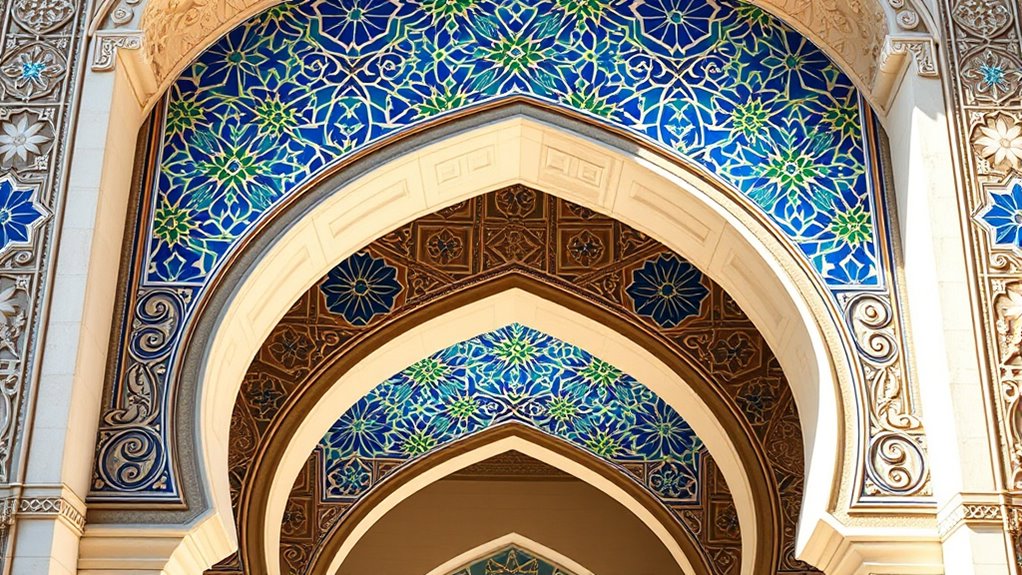
The intricate geometric and arabesque patterns are hallmark features of Moorish architecture, reflecting a deep cultural fascination with infinity and divine order. These designs often incorporate calligraphy motifs, which weave sacred texts into visual harmony, emphasizing spiritual significance. You’ll notice the use of floral arabesques, where flowing, stylized plant forms create endless, interconnected patterns symbolizing growth and eternity. These motifs serve both decorative and symbolic purposes, transforming surfaces into reflections of divine perfection. The patterns are carefully crafted to avoid representation of living beings, aligning with Islamic principles. By integrating complex geometry with organic forms, Moorish architects achieve a sense of unity and balance that elevates the spiritual atmosphere of the structures, making the patterns an essential element of their enduring legacy. Additionally, advancements in AI technology are beginning to influence the design process, allowing for even more intricate and precise pattern creation while preserving traditional artistic values.
Ornate Tilework and Zellij

Ornate tilework and zellij define the vibrant character of Moorish architecture, transforming surfaces into intricate works of art. You’ll notice how tile mosaics are carefully arranged to create stunning geometric and floral patterns, often repeating across walls, floors, and fountains. These decorative motifs not only serve aesthetic purposes but also reflect spiritual symbolism and cultural identity. Zellij, a traditional form of mosaic, involves fitting small, colored tiles into complex, tessellated designs with remarkable precision. The vibrant colors and detailed craftsmanship draw your eye, turning ordinary surfaces into mesmerizing visual displays. This intricate tilework exemplifies the Moorish mastery of decorative arts, blending artistry and technique to produce timeless beauty that continues to inspire. Additionally, the use of geometric patterns in tile design is a hallmark of Islamic art, emphasizing symmetry and infinite repetition.
Horseshoe and Muqarnas Arches
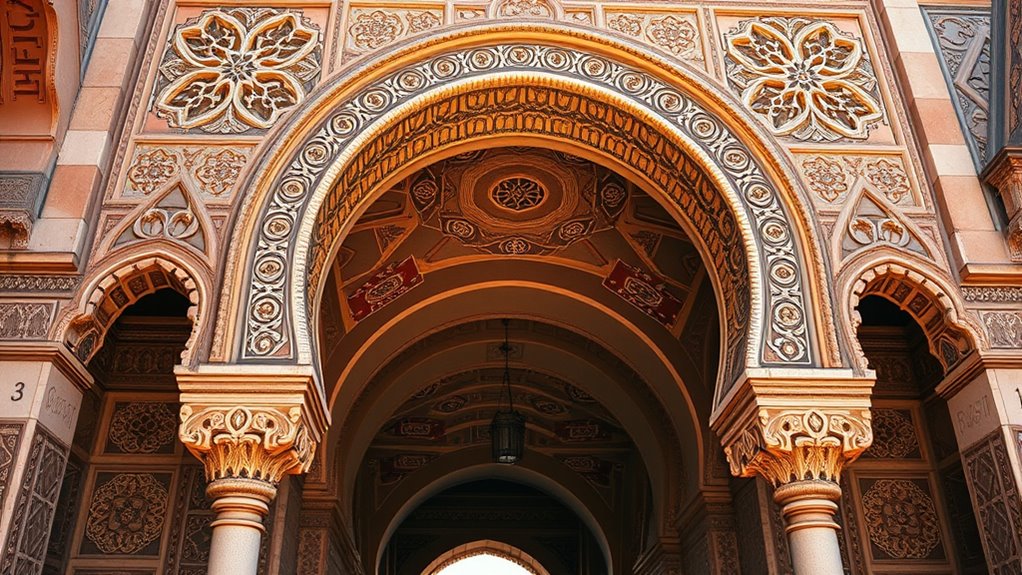
Horseshoe and muqarnas arches are central to Moorish architecture, shaping the overall structure and feel of buildings. Their unique forms enhance the architectural significance by emphasizing grandeur and spiritual symbolism. Plus, their intricate ornamentation creates a striking visual impact that captures your attention and elevates the space. Additionally, these architectural elements are often integrated with AI-driven design techniques to further refine their aesthetic appeal and structural integrity.
Architectural Significance of Arches
Have you ever wondered why arches like the horseshoe and muqarnas became defining features of Moorish architecture? Their structural symbolism goes beyond aesthetics, representing spiritual harmony and the universe’s order. These arches also showcase remarkable engineering innovations, allowing builders to create expansive, stable spaces with minimal material. The horseshoe arch’s shape distributes weight efficiently, enabling larger openings and more intricate designs. Muqarnas arches add depth and complexity, creating a sense of infinite space and divine connection. These architectural elements revolutionized construction, making structures more resilient and visually enthralling. By combining symbolism with technical mastery, Moorish architects transformed simple forms into powerful symbols of cultural identity and spiritual expression, shaping the legacy of Islamic architecture across centuries. Furthermore, the use of natural materials such as stone and wood not only enhances the durability of these structures but also reflects the organic beauty characteristic of Moorish design.
Ornamentation and Visual Impact
The intricate shapes and patterns of Moorish arches captivate the eye, transforming structural elements into powerful visual statements. Ornamentation patterns like detailed tile work, carved stucco, and vibrant calligraphy enhance their appeal, creating a rich tapestry of visual aesthetics. Horseshoe and muqarnas arches stand out for their complex geometries and layered designs, drawing attention to key architectural moments. These decorative features not only serve structural purposes but also evoke a sense of harmony and spirituality. When you observe these arches, you notice how ornamentation elevates their elegance, making them more than mere supports—they become focal points. This visual sophistication reflects the Moorish mastery of combining beauty with function, leaving a lasting impression on anyone who experiences their artistry.
Courtyards and Water Features
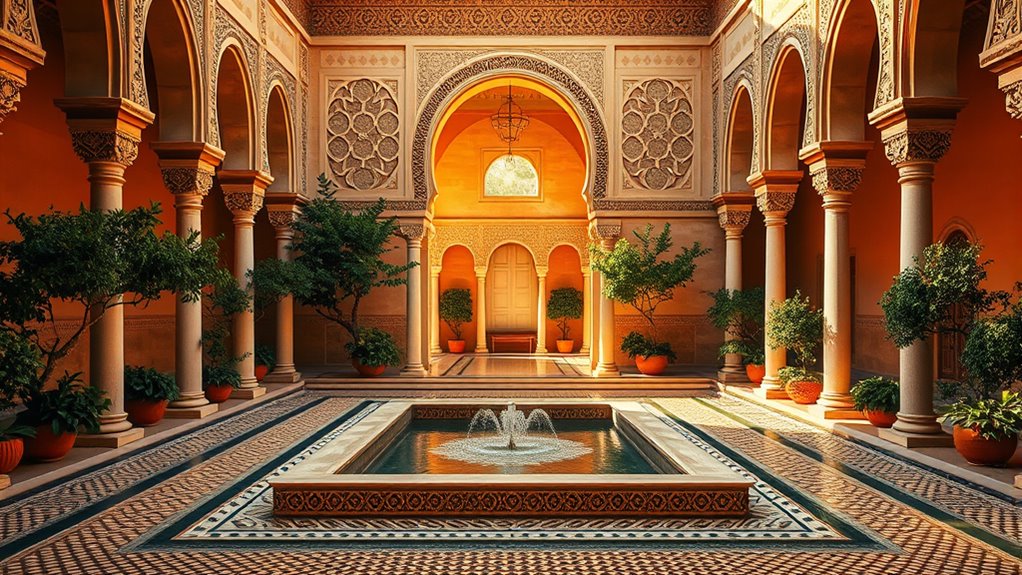
Moorish courtyards often feature central designs that create a peaceful, enclosed space. Reflective water elements, like fountains and pools, enhance the sense of tranquility and beauty. These features are essential to capturing the elegance and harmony typical of Moorish architecture. Including water features in the design not only adds aesthetic appeal but also helps regulate the courtyard’s temperature and atmosphere.
Central Courtyard Designs
Central courtyards in Moorish architecture serve as tranquil focal points that blend functional space with aesthetic appeal. These designs highlight traditional craftsmanship, showcasing intricate tilework, stucco, and woodwork that reflect skilled artisanship. The layout often emphasizes symmetry and harmony, creating a peaceful environment for reflection and social gatherings. Cultural symbolism plays a crucial role, with courtyards serving as representations of paradise or spiritual sanctuaries, reinforcing spiritual and cultural values. Water features, such as fountains or small pools, are typically central elements, adding a sense of serenity and cooling the space. By integrating these features thoughtfully, Moorish architects created courtyards that are both functional and deeply meaningful, embodying centuries-old traditions that continue to influence architectural design today. Sizing and load‑planning tools can help ensure these intricate spaces are designed with proper structural support.
Reflective Water Elements
Have you noticed how reflective water features in Moorish courtyards create a sense of tranquility and visual harmony? These tranquil reflecting pools are carefully designed to mirror their surroundings, enhancing the peaceful atmosphere. They often feature intricate tilework and lush greenery, emphasizing symmetry and beauty. The reflective water elements serve both aesthetic and symbolic purposes, representing purity and serenity. By incorporating these features, Moorish architecture achieves a calming ambiance that invites contemplation. The water’s stillness complements the geometric patterns and ornate arches. Additionally, the symbolic significance of water in Moorish design underscores its role in fostering spiritual reflection and cultural identity. Here’s a visual breakdown of ideas:
| Feature | Effect |
|---|---|
| Reflective water surfaces | Enhance serenity and symmetry |
| Tranquil reflecting pools | Create peaceful, meditative spaces |
Intricate Woodwork and Ceilings

The craftsmanship behind Moorish architecture’s intricate woodwork and ceilings showcases a masterful blend of artistry and technical skill. You’ll notice the detailed craftsmanship techniques used to carve geometric patterns, floral motifs, and calligraphic designs into wood surfaces. These elements create a sense of depth and elegance, highlighting the artisans’ precision. However, preserving these delicate features presents significant challenges. Wood is vulnerable to humidity, pests, and decay, requiring ongoing maintenance and careful restoration efforts. You might find that restoring original woodwork demands expert knowledge to replicate traditional techniques while respecting the structure’s integrity. Despite these preservation challenges, these intricate wood elements continue to exemplify the artistic mastery of Moorish craftsmen, leaving a lasting legacy of refined craftsmanship and cultural expression. Preservation challenges highlight the importance of ongoing conservation efforts to maintain these artistic features for future generations.
Use of Stucco and Plasterwork

After admiring the intricate woodwork and ceilings, you’ll notice that stucco and plasterwork also play an essential role in defining Moorish architecture’s elegance. They are used to create stunning decorative moldings and varied surface textures that adorn walls and arches. These elements add depth and character, highlighting craftsmanship. The plaster is often skillfully molded into intricate geometric patterns or floral motifs, enhancing visual appeal. Surface textures range from smooth finishes to rough, textured surfaces, providing contrast and richness. To visualize, consider this table:
| Smooth Finish | Textured Surface | Decorative Moldings |
|---|---|---|
| Elegant, sleek | Rustic, tactile | Intricate, detailed |
| Reflects light | Adds depth | Frame and highlight |
| Modern look | Traditional feel | Ornamental accents |
This use of stucco and plasterwork elevates Moorish architecture’s timeless beauty. Additionally, the surface textures and decorative moldings contribute significantly to the overall artistry and cultural expression of Moorish design.
Architectural Symmetry and Layout

Architectural symmetry and layout are fundamental to Moorish design, creating a balanced and harmonious aesthetic that guides your eye through the space. You’ll notice how symmetrical motifs dominate the composition, establishing a sense of order and stability. The layout emphasizes spatial harmony, ensuring that every element is carefully arranged to complement others. Courtyards are often central, with surrounding rooms mirroring each other to enhance balance. Archways, columns, and decorative details are positioned to reinforce symmetry, making the structure feel unified and cohesive. This deliberate organization invites calmness and clarity, allowing you to appreciate the intricate craftsmanship without distraction. By prioritizing symmetry, Moorish architecture achieves a timeless elegance rooted in harmony, making spaces both functional and visually enthralling. Additionally, design principles play a crucial role in ensuring that these structures maintain their aesthetic appeal over time.
The Influence and Modern Revival
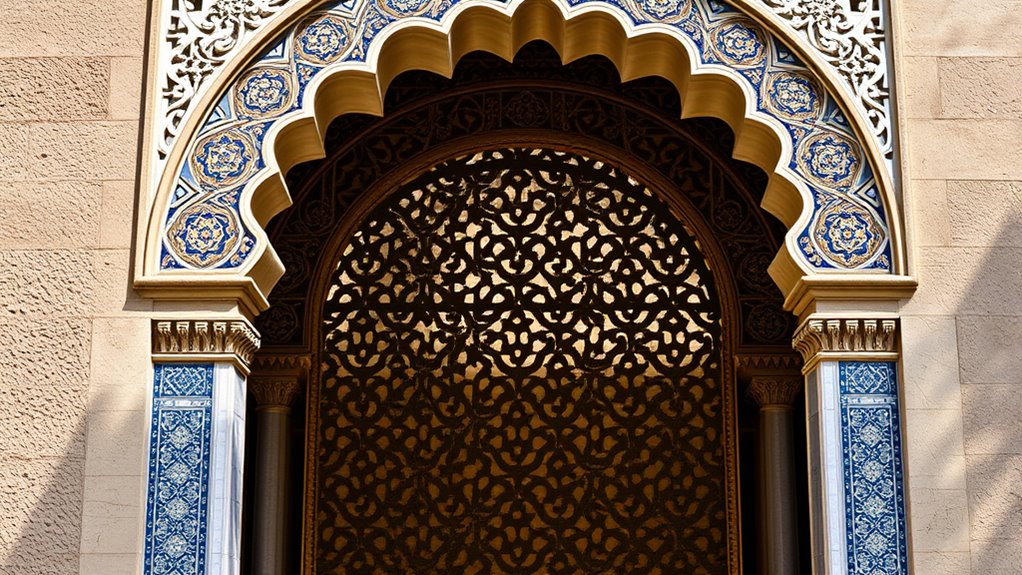
Modern architects and designers are increasingly inspired by Moorish architecture’s timeless elegance and intricate detailing. You can see this medieval influence reflected in contemporary adaptations that blend historical motifs with modern materials. These designs often feature ornate arches, decorative tilework, and complex geometric patterns, paying homage to the Moorish legacy. Many new structures incorporate elements like courtyards and stucco surfaces, echoing traditional styles while meeting today’s architectural needs. This revival isn’t just about aesthetics; it also emphasizes craftsmanship and cultural symbolism. As you explore current projects, you’ll notice how Moorish influences add depth and character, creating a dialogue between past and present. Support hours for architectural projects may vary depending on the location and the scope of the work. This ongoing inspiration guarantees Moorish architecture remains relevant, inspiring innovative expressions rooted in a rich historical context.
Frequently Asked Questions
How Did Moorish Architecture Influence European Design During the Renaissance?
You can see Moorish architecture’s influence on Renaissance art through decorative motifs like intricate tilework, arabesques, and horseshoe arches. These elements inspired European designers to incorporate geometric patterns and elaborate ornamentation into their buildings and artworks. The influence helped shape the Renaissance’s fascination with symmetry and detail, blending Islamic artistry with Western styles. As a result, Moorish decorative motifs left a lasting legacy in European architecture and decorative arts.
What Materials Were Traditionally Used in Moorish Tilework and Stucco?
You’ll find that traditional materials used in Moorish tilework and stucco include glazed ceramic tiles, often called azulejos, and lime-based stucco. The tile craftsmanship involves intricate geometric and floral patterns, showcasing skilled artisanship. These materials create vibrant, durable surfaces that reflect Moorish artistic traditions. The use of glazed tiles and fine stucco work highlights their mastery in combining functionality with decorative beauty, leaving a lasting legacy in architectural design.
Are There Specific Regions Where Moorish Architecture Is Most Prominent Today?
Ever wonder where Moorish architecture still thrives today? You’ll find it prominently in southern Spain, especially during the Andalusian Revival, showcasing its North African influence. Cities like Granada and Córdoba highlight intricate tilework and stucco details. This style’s legacy endures in Morocco and parts of North Africa too. So, if you’re exploring regions with rich Islamic history, look for the distinctive arches, ornate designs, and vibrant mosaics that define Moorish architecture.
How Did Moorish Architecture Adapt to Different Climates and Environments?
You’ll notice Moorish architecture adapts well to different climates through climate adaptation and environmental integration. In hot regions, it uses thick walls, courtyards, and shaded arcades to keep buildings cool. In cooler areas, lighter materials and strategic window placements help retain heat. This flexibility shows how Moorish design seamlessly blends with its environment, ensuring comfort while respecting local conditions and enhancing the cultural landscape.
What Contemporary Architects Are Inspired by Moorish Architectural Principles?
You’ll notice contemporary architects drawing inspiration from Moorish architecture’s timeless symbols, like intricate Islamic motifs and ornamental arches that evoke elegance and spirituality. They blend these elements into modern designs, creating spaces that reflect cultural depth and artistic craftsmanship. By incorporating these features, today’s architects honor Moorish legacy, transforming historic motifs into innovative structures that celebrate beauty, tradition, and a sense of connection across time and cultures.
Conclusion
Step into Moorish architecture, where every arch and tile tells a story of centuries past. It’s a mirror reflecting a rich cultural soul, inviting you to see beauty in intricate details and harmonious layouts. Like a timeless garden, its legacy continues to inspire and flourish, reminding you that true artistry blooms when tradition and innovation intertwine. Embrace this enduring symbol of cultural richness, and let its beauty inspire your own creative journey.




